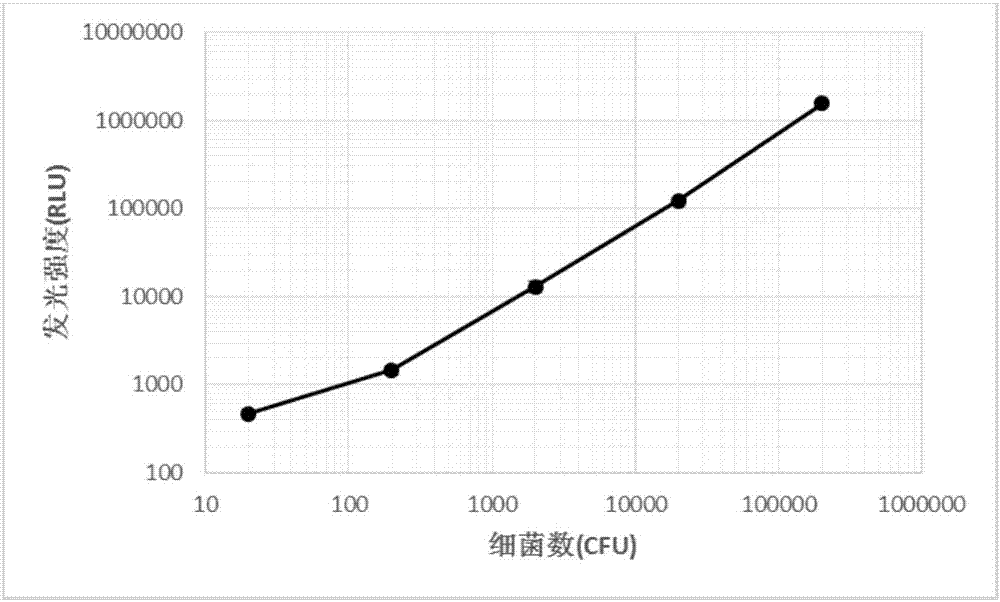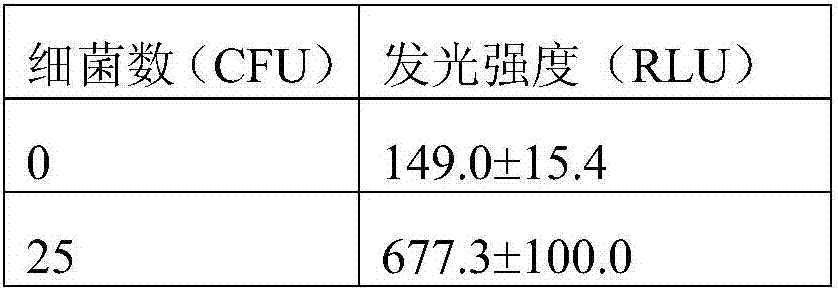Reagent capable of rapidly and quantitatively detecting sensitivity of antibacterial agent and application method of reagent
A technology for quantitative detection of antibacterial drugs, applied in the field of rapid detection of reagents for the sensitivity of pathogenic microorganisms to antibacterial drugs, can solve the problems of cumbersome operation, difficult to use in grass-roots hospitals, and small gradients of antibacterial drug concentrations, and achieve reduced operating steps and luminous intensity Stable, low-hardware-required effects
- Summary
- Abstract
- Description
- Claims
- Application Information
AI Technical Summary
Problems solved by technology
Method used
Image
Examples
Embodiment 1
[0066] Example 1 Preparation of bacterial ATP detection reagent
[0067] Follow the steps below to prepare bacterial ATP detection reagents:
[0068] (1) Use freshly prepared high-purity water to prepare 100mL 150-250mM N-2-hydroxyethylpiperazine-N'-2-ethanesulfonic acid (HEPES) solution; add 0.15-1.20g chlorhexidine acetate, 1.5-2.5 mL Triton X-100 (Triton X-100), 0.3-0.5g magnesium chloride hexahydrate, 0.7-1.0g disodium ethylenediaminetetraacetic acid dihydrate (EDTA); use 1M sodium hydroxide to adjust the pH of the solution After 7.5, use a 0.22 μm filter membrane to filter and sterilize; add 20-50 mg luciferase (Sigma) and 100-200 mg D-luciferin (Sigma), dissolve, and store at -20°C.
[0069] Or (2) Use freshly prepared high-purity water to prepare 100mL 150-250mM N-2-hydroxyethylpiperazine-N'-2-ethanesulfonic acid (HEPES) solution; add 0.06-0.10g cetyltrimethyl Ammonium bromide (CTAB), 0.15-1.20g chlorhexidine acetate, 1.5-2.5mL Triton X-100 (Triton X-100), 0.3-0.5g magnesium...
Embodiment 2
[0071] Example 2 Bacteria ATP detection reagent detects bacteria
[0072] In order to investigate the performance of the bacterial ATP detection reagent, Escherichia coli (ATCC 25922) and Staphylococcus aureus (ATCC 29213) were resuscitated on TSA plate medium and cultured at 37°C for 18-24 hours. Dilute the two bacteria with CAMHB broth to a series of concentrations, transfer a certain volume of the diluted bacteria solution to the blank multi-well plate, add a certain volume of the bacterial ATP detection reagent prepared in Example 1, and put it into the multi-function plate reader (PerkinElmer), detect the luminescence value of each well, repeat three wells for each concentration.
[0073] Table 1 and Table 2 show the luminescence values of different amounts of Escherichia coli and Staphylococcus aureus, respectively. figure 1 with figure 2 Shown is the relationship between the detected luminous intensity and the number of bacteria. It can be seen from the figure that the l...
Embodiment 3
[0079] Example 3 Detecting the number of bacteria after antibiotic action
[0080] In order to detect the changes in the number of bacteria after 2 hours of antibiotic action, Escherichia coli (ATCC 25922) and Staphylococcus aureus (ATCC 29213) were resuscitated on TSA plate medium and cultured at 37°C for 18-24 hours. In a 96-well plate, use column 1 as a negative control, and column 6 as a positive control; row A is cefazolin, rows B and E are piperacillin, rows C and G are netilmicin, and row D is levofloxacin , Line F is minocycline. Add 50μL of CAMHB broth to each well of column 1 to 6 of the well plate, and dilute the antibiotics with CAMHB broth to the required concentration (cefazolin 4μg / mL, piperacillin 16μg / mL, netilmicin 2μg / mL, levofloxacin 0.125μg / mL, minocycline 1μg / mL), add 50μL of the antibiotic diluent of the above concentration in column 2 to the corresponding row, and use the stepwise dilution method to dilute the antibiotic to 3-5 Remove the extra 50μL sol...
PUM
 Login to View More
Login to View More Abstract
Description
Claims
Application Information
 Login to View More
Login to View More - R&D
- Intellectual Property
- Life Sciences
- Materials
- Tech Scout
- Unparalleled Data Quality
- Higher Quality Content
- 60% Fewer Hallucinations
Browse by: Latest US Patents, China's latest patents, Technical Efficacy Thesaurus, Application Domain, Technology Topic, Popular Technical Reports.
© 2025 PatSnap. All rights reserved.Legal|Privacy policy|Modern Slavery Act Transparency Statement|Sitemap|About US| Contact US: help@patsnap.com



